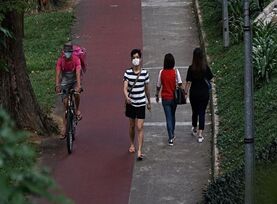新加坡首次发布行人守则
|
Pedestrians are urged to stay away, if possible, from paths they have to share with cyclists. But if they must use these shared paths, they are advised to keep left unless they are overtaking another pedestrian. Another good practice the authorities want pedestrians to adopt is to refrain from using their mobile phones while walking on shared paths. These are some of the suggested habits set out by the Land Transport Authority (LTA) in Singapore's first code of conduct for pedestrians. It came into effect this month, on Aug 1.
The new code is an addition to the existing code of conduct for other users of public paths, such as cyclists and e-scooter riders. It is also part of measures proposed late last year by the Active Mobility Advisory Panel (AMAP). Yesterday, LTA said it will roll out a campaign to encourage gracious behaviour on shared paths and footpaths by the end of this year. National University of Singapore transport infrastructure expert Raymond Ong welcomed the new code, saying a pedestrian who is not distracted will be better able to avoid accidents. "Pedestrians need to understand that they have a role to play in ensuring their own safety," he added. "Also, in Singapore, we don't have a lot of physical space to create separations between paths, so it is more about shaping behaviour and trying to make the environment more conducive for walking and cycling." He did not think penalties are the answer to developing good behaviour. "What is important is to educate the public such that the behaviour becomes intuitive," he said. Other LTA-recommended behaviour for pedestrians includes using pedestrian crossings on roads instead of bicycle crossings as well as refraining from listening to music in a way that will prevent them from detecting danger or oncoming obstacles. But Mr Francis Chu, co-founder of cycling group Love Cycling SG, said the pedestrian code of conduct was unnecessary. "Formalising keeping to the left while walking can cause some aggressive riders to shift the blame to the victim in the case of an accident," he said. He further pointed out that some pedestrians, such as the elderly and young children, may not be able to keep left and be alert at all times. "If the main objective is safety for all path users, aren't the two simple rules of riders giving way and keeping a safe distance from pedestrians sufficient?" he added. Besides the pedestrian code of conduct, two other rules for mobility safety also took effect this month. One is the ban on those aged below 16 from riding electric scooters without supervision, and the other is making it an offence for cyclists and PMD users to use their mobile phones while riding. For adults supervising underage e-scooter riders, LTA wants them to keep their eyes on one rider at a time and not to let them out of their sight. They need to also educate the young rider about safe riding and the relevant regulations, like not exceeding 25kmh on a cycling path. |









